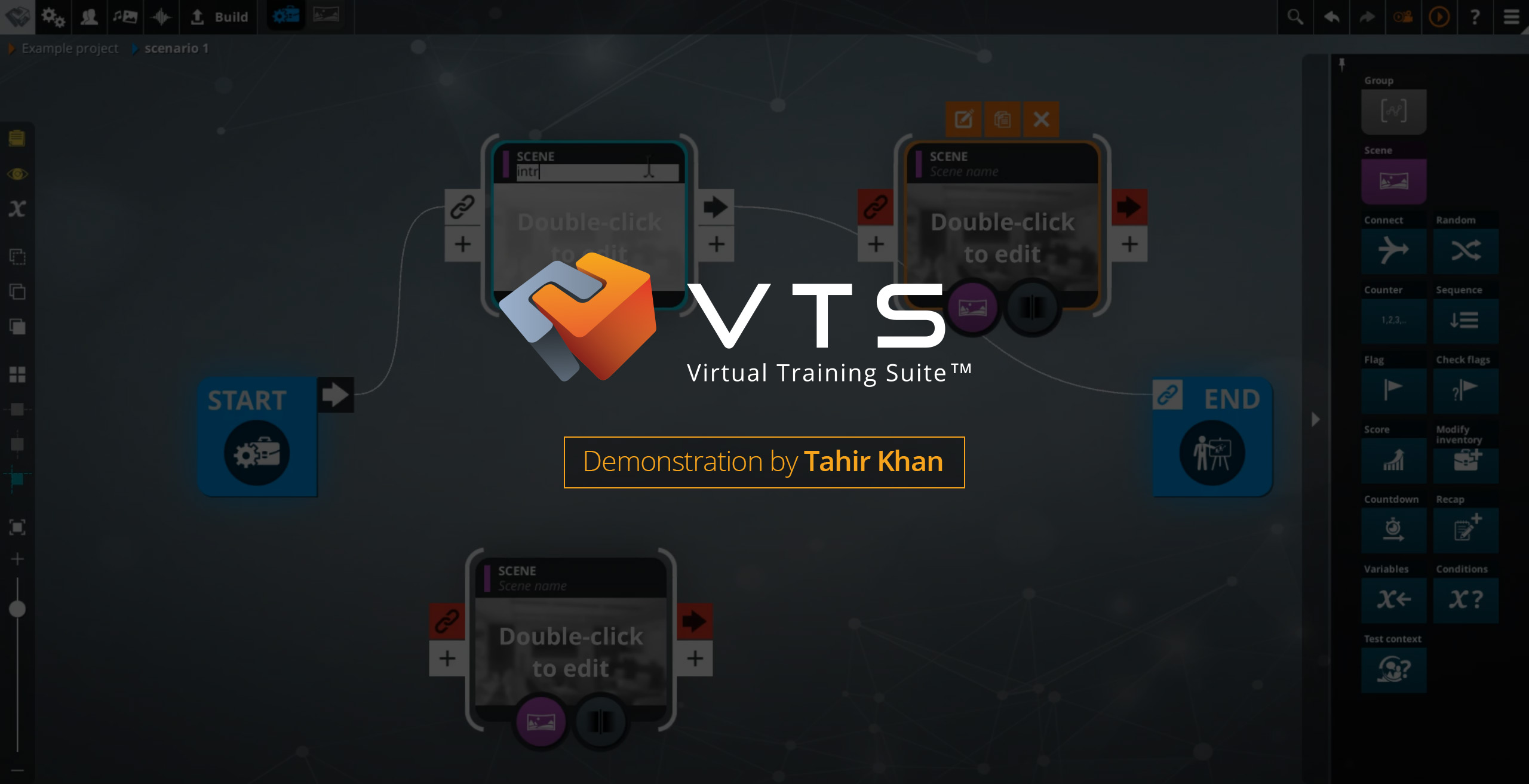Why and How to Evaluate the Impact of an E-Learning Module
Training managers, instructional designers, HR professionals: your responsibilities don’t stop at publishing a module and watching completion rates rise. The real challenge is twofold: are employees learning what was intended? And is that learning translating into tangible results for the organization? To measure e-learning effectiveness, connect these two dimensions with accurate measurement and a recognized evaluation framework to fuel a continuous improvement loop. Specifically, you will: 1) clarify the “skill → business indicator” link; 2) structure measurement using Kirkpatrick (and Phillips for ROI); 3) instrument your module and your data tools (LMS/SCORM + VTS Editor/Perform); 4) analyze, segment, iterate.
Connecting Learning Goals with Business Objectives to Measure E-Learning Effectiveness
From Competency to Business KPI
Right from the start, translate learning objectives into observable behaviors and connect them to relevant business indicators. A compliance module should reduce incidents and penalties; a sales module should increase conversion rates or average cart value; a safety module should decrease accidents and near misses. This mapping helps avoid vanity metrics (completion going up without real impact), guides KPI selection, and supports ROI calculation.
Example: a sales argumentation serious game targets the skill “needs discovery” → intermediate indicator “rate of reformulation in simulation” → business indicator “+2 points in conversion” within 60 days. Discover how gamified e-learning modules make this chain more visible and measurable.
Real-World Examples Aligning Learning and Results
For sensitive topics like cybersecurity, a short immersive format anchors the right habits and allows for cold tracking. Example: the “CyberSmart” project rolled out at scale with VTS Perform (Thales case study), which links behaviors in simulations to incident indicators and retention of best practices.
Kirkpatrick and Phillips: Frameworks for Evaluating E-Learning Effectiveness
The 4 Levels of Kirkpatrick
- Reaction: satisfaction and perceived usefulness.
- Learning: pre/post-tests, evaluations.
- Transfer: application on the job.
- Results: impact on business indicators.
Add Phillips’ ROI model when stakes or investment are high. Formula: ROI% = (Benefits – Costs) / Costs x 100. Simple example: a reduction of 25 annual incidents at €500 each saves €12,500; if the module costs €8,000, ROI = (12,500 – 8,000) / 8,000 = 56.25%.
To go deeper into measuring transfer, see the landmark review by Baldwin & Ford (1988). For comparative e-learning effectiveness, refer to Sitzmann et al. (2006). For gamification benefits, see the meta-analysis by Sailer & Homner (2020).
Using Data to Drive Continuous Improvement
Iterate Through Versions and Tests
A high-performing module is never “done,” it’s versioned. Test variants (A/B), analyze user journeys, identify friction points, reinforce what works. VTS Editor facilitates these cycles: instrument interactions (quizzes, phrase choices, clickable zones), score per competency, adapt pathways, track micro-conversions, and observe actual effects of changes in your LMS and VTS Perform.
Defining the Right KPI to Evaluate an E-Learning Module
Your KPIs must tell the full story: adoption, learning, application, impact. Think “from click to competency, from competency to result.”
Adoption and Engagement KPIs
Beyond completion, observe depth of use. Combine activation rate, drop-off rate by stage, median time spent and its distribution. Track media consumption (videos watched to the end, navigation through slides), resource openings, and interactions triggered within the environment. Gamification mechanics (badges, progress bars) are micro-conversions: well-placed, they often predict learning journey continuation. Always segment by job role, country, language, device, and version: the same design won’t perform equally everywhere.
Learning KPIs (Performance)
Measure pass rate, average score, and attempts on final assessment, but also the effectiveness of learning activities. Vary formats (single/multiple choice, true/false, drag-drop, matching, text/number input, sliders). Score by competency, set orientation thresholds (remediation vs enrichment), track pre/post-test progress to objectify gain. A +20-point delta on a compliance topic coupled with fewer incidents builds a strong case with business stakeholders.
On-the-Job Transfer KPIs
Transfer means applying learning at work. In simulations or serious games, measure decision-making quality, prioritization, time management, error reduction. Mark checkpoints (e.g., identity verification before a sensitive action). After 30–90 days, collect self-reported application and manager feedback. Cross-check this with system data: error rates, customer feedback, delays.
Business KPIs and ROI
Define business indicators with operations: reduction in incidents/accidents, fewer complaints, increased conversion, productivity gains (time saved), reduced time-to-proficiency. Make monetary benefits explicit (savings, additional revenue, cost avoidance) and factor in costs (design, licenses, media production, deployment, learner/manager time).
Success Thresholds and Benchmarks
Set realistic targets and calculate internal benchmarks. Examples: completion > 80%, pre→post gain > 20 points, final pass rate > 70%, cold application > 60%, NPS > 30. Then compare by cohort (country, role, language, seniority), by format (serious game vs linear module), and over time (successive versions). Your “top 25% of modules” becomes the standard to beat.
Measurement Methods: Tests, Observation, and Analytics
Measurement validity relies on triangulating sources: combine tests, observation, and use data to cover all levels of Kirkpatrick.
Pre-Test / Post-Test
Goal: objectify individual and group progress. Design a short pre-test (5–10 representative items). The post-test should be of equivalent difficulty (different contexts) to avoid memorization effects. In VTS Editor, use evaluation blocks, score by competency, and store results. Analyze individual deltas, progress distribution, and discriminating items (those failed by more than 40% of learners) that point to concepts needing reinforcement.
Formative and Summative Assessments
Implement regular checkpoints with immediate feedback. A failed drag-and-drop task can trigger a scripted remediation (followed by a new attempt measured by a counter). The final assessment defines a pass threshold aligned with expected level; send status and score to LMS via SCORM. Measure time when it’s a critical factor (calls, incidents).
On-the-Job Observation (Simulations/Serious Games)
Simulations create a bridge to the real world. A “handling angry customers” scenario can combine dialogue choices (active listening), clickable zones (tools to use), and metacognitive scoring (communication, resolution). Mark key steps (“did they rephrase? did they offer a plan of action?”). Then compare “winning” vs “costly” journeys and adjust pedagogy accordingly.
Structured User Feedback
Immediately after use, ask about clarity, perceived usefulness, cognitive load, and intent to apply; leave space for suggestions. After 30–90 days, measure frequency of application and obstacles, and collect manager feedback. Cross these qualitative insights with evaluation results to expose actual levers: sometimes, knowledge is gained but contextual barriers (procedures, tools, local priorities) block transfer.
A/B Testing and Control Groups
Test a narrative, a type of media, more detailed feedback, or a gamification level. In VTS Editor, randomly assign learners and retain assignment for analysis. Track completion, scores, time, transfer, and if possible business indicators. If your sample size is sufficient, deploy the winning variant and iterate. If the stakes are high, add a non-exposed control group to isolate the effect of training.
User Journey Analysis and Micro-Conversions
Map the journey: where does the learner start, where do they drop off, which scenes slow them down, which media are skipped? Define micro-conversions: video watched to 100%, resource consulted, badge earned, task completed on first try, deadline met. In VTS Editor, instrument these points with scores, progress, badges, counters, and variables, and push them to your analytics platforms (BI, warehouse) via web requests. In preproduction or on desktop (Windows/Mac), a local summary eases diagnostics.
Key Tools: LMS/SCORM, Dashboards, and VTS Editor
Tracking via Your LMS (SCORM) and Data Visualization
SCORM records completion, final score, time, status (passed/failed), and attempts. Build dashboards with funnels (start → checkpoints → final), abandonment heatmaps, and time per step. Segment by audience, country, language version, device, and version. Deploy basic alerts: unusually low completion, high failure rate, large version discrepancy.
Instrumenting Modules in VTS Editor
Performance side: add multiple measurement points such as quizzes, true/false, drag-and-drop, matching, text/number fields, sliders. Score by competency, define thresholds, adjust progress (percentages, pass/fail). Engagement side: track attempts, time pressure, milestones (badges), interactions (click zones, items), media consumption (videos, slides), and resource access. For testing: use random distribution and branches; for adaptive logic: state flags; for multilingual delivery: language-based conditions. Variables capture learner state; variable media avoids duplicating blocks; web requests send/receive events; reusable functions structure content; reset blocks allow replay of identical interactions.
Analytics with VTS Perform
VTS Perform consolidates key learning data: sessions, progression, top scores, badges, replayability, time spent, cohort comparisons. Identify high-friction scenes, overly easy or hard activities, and content that best anchors competencies. Crossed with your LMS, it gives a 360° view: administrative (completion, compliance) and pedagogical (simulation behavior).
Integrations and Advanced Data Collection
Via variables and web requests, push custom events to your analytics tools (e.g., “safety resource accessed after critical error”). You can also import external data (profile, objectives) to personalize experience and refine assessment. For A/B: assign, route, and log cohort allocation for analysis. In test environments, a local summary aids diagnostics.
Data Governance (Quality, GDPR, Frequency)
Define a measurement plan: objectives, KPI definitions, sources, frequency, owners, alert thresholds. Comply with GDPR: minimize personal data, specify purpose, contractually frame processing, ensure security, and apply limited retention. Standardize nomenclature (variable names, competencies, scenes), implement quality checks (outliers, scores > 100%). Organize governance: monthly reviews for operational KPIs, quarterly reviews for impact/ROI and improvement roadmap.
Measure to Train Better: From Data to Action
Evaluating e-learning effectiveness means orchestrating a triptych: KPIs aligned with business, complementary methods (tests, observation, analytics), and integrated tools (LMS + VTS Editor/Perform). Properly scoped with Kirkpatrick/Phillips, instrumented with VTS Editor blocks and tracked with actionable dashboards, your system becomes a learning system itself: it improves with every version, and each version improves your teams’ performance. To keep assessing e-learning effectiveness and maximizing impact, draw inspiration from our client cases and best practices.
5-Step Action Plan
- Define goals and KPIs: link skills to business impact, set thresholds, map out your Kirkpatrick levels, and ROI if relevant.
- Instrument the module: configure scoring and progress, insert formative and summative evaluations, track micro-conversions, and prepare A/B testing.
- Deploy and collect: publish via SCORM in your LMS, centralize analytics in VTS Perform, check quality and GDPR compliance.
- Analyze and segment: review learning paths, identify drop-off points, tough items, simulation behaviors; segment by population, language, device, version.
- Iterate to maximize effectiveness and ROI: run targeted A/B tests, simplify complex steps, tweak feedback and remediation, reinforce engagement (gamification, media), recalibrate objectives and scenarios each cycle.
Useful Resources
- Discover the authoring tool: VTS Editor
- Deploy and measure: VTS Perform (LMS)
- Project inspiration: Thales customer case
- Learn about gamified modules: Gamified E-Learning Modules










